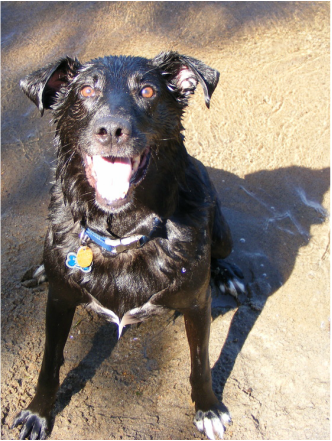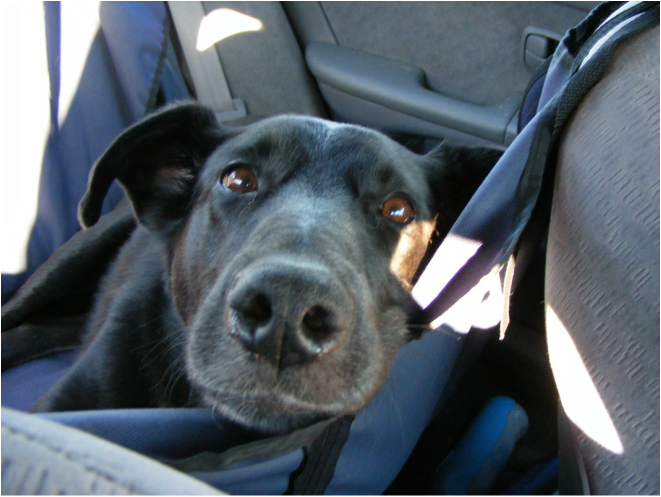Travel safely with your dogOf all the trips I've taken, some of my absolute favourites have been road trips with my beloved Chester, a now 9 year old black lab mix that my husband and I adopted nearly 5 years ago from our local Humane Society. Chester has come a long way in his travel skills over the years. His first car ride with us - was a reluctant affair, as we had to hoist his rump into the car as we left the shelter! Within 48 hours, however, he was a pro and will now come running at the slightest hint of a ride. We've taken Chester along for over a dozen camping trips, long haul rides to Northern Ontario, and a couple of week-long tours throughout the Canadian Maritimes. Just like travelling with kids, travelling with a dog is a constant learning process. Here's some of the knowledge we've gained along the way! 1: Protect your car. We use a "car hammock". This heavy duty, quilted fabric loops over the headrests of the back and front seats, protecting the back seat from fur and creating a barrier from the dog climbing into the front seat. Look for hammocks with a few pockets to store leashes and bags and adjustable straps to ensure a snug fit. Remove any "temptations" for the dog - clear out food wrappers and used dishes from underneath the seat. If your dog is prone to motion sickness, consider covering the main part of the hammock with a disposable sheet  Tags for Vaccinations, Name, Cell #, Email Tags for Vaccinations, Name, Cell #, Email 2: Protect your dog. Your dog should always wear a properly fitted collar with a name tag that lists a cell phone number or email - your home address or land line are of little help during a road trip. All dogs should have an identification microchip. It will save constant worry and ensure prompt return if your dog gets lost. Bring along some printed photos of your dog if they are prone to dashing away. If you can see forming a search party in your future, having some photos on hand will make your unpleasant task much more manageable. Eliminate escape opportunities - never leave a dog unsupervised in a strange location. You would be amazed at what tiny hole they can get through. Chester, at 85 lbs, once escaped from a bedroom via a low window that only opened about a foot wide! Temperature control is critical for dogs. They should never be left in a car, and absolutely never in a car with the windows rolled up. Likewise, they should never be left outside when you are not there. When you are in an unfamiliar location you may not realize how quickly the evening temperatures can reach freezing, or how harsh the rain can be. Safety matters for dogs as well. There are special seatbelts for dogs as well as lifejackets. Even excellent swimmers should wear a canine lifejacket on a boat trip. Bring along a pet first aid kit. Basic supplies will help for both big and small emergencies. Saline spray for cleaning wounds, antibiotic ointment, gauze pads, elastic wrap bandages, tweezers, ice packs, scissors, activated charcoal, and a blanket can all come in handy - and it's good to have most of these supplies on for humans as well! 3.) Chow time. Bring more food than you think you will need. We pack ours in a collapsible canvas container that is flexible enough to squeeze down when almost empty, but sturdy enough to hang from a tree while camping. If your brand is a unique one, make sure that your supplies are not only plentiful but that you have a source of it at your destination as well. Always have water at hand. We travel with a collapsible bowls from Sea to Summit (actually made as a backpackers/hiker's collapsible stew bowl!) and a Gulpy water bottle. We bring several extra liters of water with us for refills Bring a small bag of treats for your dog - especially breath treats! It will be stinky in the car if you don't. Stuffing a toy with treats and sealing it with peanut butter can keep a dog happy and amused for a long time! Keep meals at regular intervals and try to keep on the same schedule you have at home. This is important for both your dog's digestion and for his reassurance and security. Meals are important for you too! When visiting restaurants with a dog, one person should approach the staff first and see if it's okay if your dog joins you on the edge of the outside seating. Generally, you will have the greatest success with casual establishments at off-peak hours. We always generously tip those waiters who bring a bowl of water or give him a little attention. 4.) Sweet dreams. Try to keep the same when you travel. When we are camping, I bring Chester in the tent with me when I go to bed. While he is often curious to hear Ryan's voice from across the campground, he is usually so tired after a long day of play, he settles down and falls asleep right away. Bring along his favourite bed or blanket for his comfort and reassurance! One thing I've been meaning to do - sew a ribbon or elastic on one corner of his bed so it's easier to haul around. Carefully read hotel policies - often so-called "Pet Friendly" hotels will restrict their policies to dogs under a certain size, or have a one time cleaning surcharge that can be up to $50. Remember that when you blind book a hotel on a 'name your own price' aggregation site, keep in mind that selecting a pet-friendly hotel is rarely an option. Have a back-up plan if your winning bid isn't Fido friendly. Sneaking your pet into a non-welcoming establishment will only result in trouble and fines. When you find a hotel chain you like that has a dog policy you can manage, become familiar with their prices and their booking procedures When we had our tent disaster during a rained out camping trip last summer, we knew that the Comfort Inn had an "all dogs welcome" policy and we quickly booked with them. Ask for a hotel room in a quiet area with easy access to an exit. This allows us easy access for walks and breaks and keeps an excited dog away from the refinement and business of the lobby area. When checking into a hotel room, it's a good idea to briefly leave for a few minutes and then return, leaving your dog in the room. This teaches them that you are going to leave and you are going to return. His hotel domain will be like his home domain - when family leaves, they WILL return. This should cut down on anxiety and any additional barking that might come with it. Consider getting a hotel package that includes pizza and a movie. We did exactly this at the dog-friendly Prince George Hotel in Halifax. While the package was designed for people with teenage kids, we got a great deal on the room, enjoyed a full pizza meal, and since we were not going to leave the dog for evening we got to enjoy a movie in the hotel. When we checked in, we got a complimentary "doggy bag" that included a gourmet biscuit, loan of a blanket and water bowls, and a dog magazine.  5.) Time for Fun! Most public parks, botanical gardens, museum grounds, hiking trails, beaches, and waterfronts, art-in-the-park and Shakespeare-in-the-park are often dog friendly or have dog friendly sections. Watch carefully for signs and make sure to adhere to leash rules. Check websites or call ahead to find out more information. Some National Historic Sites welcome dogs on their grounds and around ruins. Many cities have dog friendly cafes attached to specialty pet shops. Consider visiting galleries, museums, amusement parks that offer all day come and go tickets. You can visit in short intervals that are appropriate for your pet's needs. Travelling with a pet is a great time to indulge your individual interests and passions. While one person can enjoy quiet time with your pet, the other person can go to an attraction or show they are very keen on without dragging a reluctant spouse or friend along. Travelling with a pet is also a great time to do quiet activities in your tent or hotel room that allow you to have fun and relax without worrying about how your dog will manage. Catching up on reading or crosswords, playing board games, making elaborate campfire meals, playing camping "sports", watching movies, and having trivia contests are great dog-friendly activities.  6.) Practicalities: Make sure your pet is in good health to travel. Customs officials have the right to ask for a letter from your vet declaring the dog to be in good health and disease free. If you feed your dog a fresh food or make homemade food for your dog, be aware that it is subject to the same rules as any other food product as your cross borders. In particular, fresh meat products are subject to inspection. You should always travel with your dog's vaccination records and be prepared to present it when you cross borders and when you check into some state parks. Some non-essential vaccines may also be required at doggy hotels and day camp programs. If you travel with medication for your pet, bring it in an official prescription bottle or with a copy of the prescriptions. Consider your pet's medication and health needs if you are travelling to a new region with new environmental factors - like ticks! Invest in additional vaccines and preventative medications, such as Revolution. Did you know that Blastomycosis can affect humans and dogs visiting Georgian Bay, Northwest Ontario, and Manitoba? Be sure to present a travel history to your vet if you return with unusual symptoms. Bring a list of local veterinarians and animal hospitals when you travel. When we did a 2 week road trip through the Maritimes, I had to take listings for over a dozen communities. The reassurance was worth it. Pre-Book your dog in for a grooming session when you get home - trust me, they'll need it! My husband mocked me mercilessly when I first wanted to do this BUT: have a suitcase or backpack for your dog. Nothing will frustrate you more than constantly searching for a stray toy, a poop bag, a treat. When you arrive at your destination, you will want to set your dog's supplies up right away to make them feel at home. You are going to have your hands FULL trying to juggle an excited dog, a dog bed, your personal belongings, your dog's supplies, and unfamiliar keys. So throw on a backpack and free up some hands! 7.) When you take off and leave your pooch at home!
When using a dog boarding facility, choose one that comes well recommended by a pet owner you know personally. Visit it before your trip to inspect it and consider a short term. Ask how much exercise they will get, how much outside time, how much personal attention. Discuss the facilities procedures for handling emergencies and leave extensive contact information for a local friend that you trust. In addition to the items listed below, consider leaving an old T-shirt or pillow case with your dog. The familiar scent will be comforting for him. Friends may often volunteer to care for your dog, but unless you are facing an emergency situation, think twice before accepting their offer. Dogs are a lot more work than non-pet owners can imagine. When returning home, allow your dog ample bathroom opportunities and spread out their food consumption so they do not gobble too quickly in their excitement. Please read the Next Entry for my doggie packing list. If you enjoyed this article, you'll also like: Stuffed Bags Containing Stuffed Animals Trip Planning Challenge Comments are closed.
|
�
Recent Posts
Posts by Location
Post Categories
All
Posts by Date
June 2024
|
Disclaimers, Privacy, and Cookie Policy |
Top 100 Travel Influencer
As named by the Obama White House in 2014. |
© COPYRIGHT 2024. ALL RIGHTS RESERVED.
|













